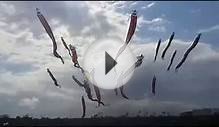
 The Balinese traditional kites are gigantic and have evolved into increasingly bombastic proportions over the years, measuring up to four metres in width and 10 metres in length. Some other versions, such as the ‘janggan’ type have impressive flowing ribbon tails often reaching 100 metres or more in length. Jointly built at the communal ‘banjar’ village halls all over Bali, skilled youths, supervised by elders, craft bamboo frameworks for weeks up to the major event. Lightweight fabrics are selected according to an agreed-upon colour scheme and some are fitted with intricately carved heads. The final results await transport – usually by truck and requiring special escort along small Balinese roads – towards the Bali Kites Festival flying grounds on Padanggalak Beach.
The Balinese traditional kites are gigantic and have evolved into increasingly bombastic proportions over the years, measuring up to four metres in width and 10 metres in length. Some other versions, such as the ‘janggan’ type have impressive flowing ribbon tails often reaching 100 metres or more in length. Jointly built at the communal ‘banjar’ village halls all over Bali, skilled youths, supervised by elders, craft bamboo frameworks for weeks up to the major event. Lightweight fabrics are selected according to an agreed-upon colour scheme and some are fitted with intricately carved heads. The final results await transport – usually by truck and requiring special escort along small Balinese roads – towards the Bali Kites Festival flying grounds on Padanggalak Beach.
The ‘bebean’ type is the most common design with a traditional outline of a fish, and is the common ‘giant kite’ of Bali that dominates the skies. The ‘janggan’ somewhat resembles birds with shorter and rounder wings and their long flowing ‘kedeber’ ribbon tails often outshine the kite’s body once airborne. In each competition, the task of assembling and flying the entailing ‘kedeber’ is major challenge for the piloting troupe that normally comprises a dozen or so boys and men. Categories to win include ‘best launch’, ‘best design’ and the ‘longest flight’. Occasionally, the kites descend over nearby rice paddies, and team members must dash through the coast onto the fields to retrieve the hard-earned and painstakingly built kite before it gets soaked.
Although the skies over Padanggalak are dominated by these flying giants during the Bali Kites Festival, you’ll witness kite-filled skies on any given day between June and August - every year. At this windy time of the year, the skies over Bali are just as elaborately decorated as any Balinese procession. Some kites are even fitted with sound instruments in the form vibrating bows called ‘guwang’, which generate a resonating hum that can be heard from far. Enjoy Bali’s windy season sights and sounds!
Don't worry if you missed out on a main festival event. There are various competitions to witness throughout the second half of the year. Stay tuned for the complete line-up of 2016 Bali kite events, as announced by the Bali Kites Association or Pelangi (Persatuan Layang-Layang Bali). The following dates may shift following favourable weather conditions:
1. Bali Kite Festival: 3-5 July, Padanggalak Beach, Sanur
2. Gianyar Kite Competition: 31 July-2 August (tentatively 8-9 August), Padanggalak Beach, Sanur
3. Denpasar Kite Competition: 7-9 August, Padanggalak Beach, Sanur
4. Biaung Kite Competition: 14-15 August, Padanggalak Beach, Sanur
5. Tanjung Kite Competition: 21-23 August, Mertasari Beach, Sanur
6. Sanur Village Festival Kite Competition: 28-30 August, Mertasari Beach, Sanur
7. Penatih Kite Competition: 4-6 September, Penatih, Denpasar
8. Ungasan Kite Competition: 11-13 September, Ungasan, Bukit Peninsula
9. Tabanan Kite Competition: 18-20 September, Tabanan
10. Belega Kite Competition: 18-20 September, Belega, Gianyar
11. Bekul Kite Competition: 2-4 October, Padanggalak Beach, Sanur
YOU MIGHT ALSO LIKE










